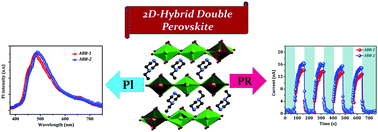Semiconductivity and high stability in centimetric two-dimensional bismuth–silver hybrid double perovskites†
Abstract
The substitution of the toxic element lead in metal halide hybrid perovskites has been receiving tremendous consideration because poor stability and high toxicity are two of the main issues hampering their further uses. Recently, lead-free bimetallic hybrid double perovskites (BHDPs) have shown various environmental and structure–property advantages over the pristine APbX3 compounds. However, the number of synthesized BHDPs is quite limited and the exploration of their physicochemical properties is still in a very early stage. Herein, two new centimetric BHDPs, namely (H2EPZ)2[BiAgBr8] (ABB-1) and (H2MPA)2[BiAgBr8] (ABB-2), are quasi-two-dimensional with a unique Dion–Jacobson structure, in which the cyclic diammonium cations (1-ethylpiperazinium = H2EPZ and 1-methylpiperidinium-4-amine = H2MPA) are separated by [BiAgBr8]n4n− layers. Interestingly, in addition to strong photocurrent response (the ratio of Ilight/Idark reaches 95 and 89 for ABB-1 and ABB-2, respectively) and bluish-white broadband emission, ABB-1 and ABB-2 showed efficiently enhanced proton conductivity of ∼9 × 10−4 S cm−1 dependent on temperature and humidity change. This is by far the best BHDP conductive material. Adequate surface coverage thin films of both compounds can be facilely prepared. Moreover, these films are highly stable. The morphologies of these films remain unchanged for a record of 90 days at a relatively high RH of 55%, which paves the way for optoelectronic applications.



 Please wait while we load your content...
Please wait while we load your content...